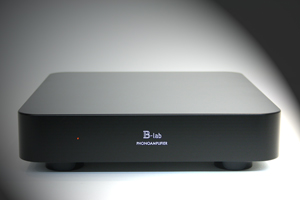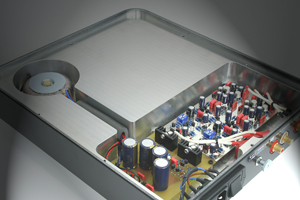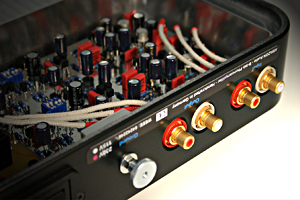B-lab - the history
B-lab is still a familiar brand name for all aficionados of the 80s scene when the B-lab preamplifier with included phono stage was a long-time reference device of the legendary German hifi magazine “Das Ohr” (“The Ear”), which was held in high esteem due to its objectiveness (free from manufacturer advertising) and occasionally highly critical reviews. Even then, the innovative circuit designs of Bernward Schulte, who studied both mathematics and physics, raised the eyebrows of those who embraced high-end music playback. Since then, Bernward Schulte has continued to improve his circuitry concepts based on his ingenious basic idea. The MC phono is the result of these efforts, and it is setting a new standard not least due to its solid aluminum case and finest components used. .
B-lab - the phono stage
The B-lab-phono stage combines excellent measured values, especially concerning the accurate adherence to the RIAA curve, with outstanding dynamics and an exorbitant sound stage in both width and depth.
|

|
MC-preamplifier board:
The preamp stage employs relatively few components and works in complementary symmetrical Class A mode and, thanks to the idle current concept of the input transistors, with an especially low noise level. It is worth noting that the preamp stage adjusts automatically to the connected MC cartridge by integration of its inductor parameters. In practical terms this means that the usual hunt for the optimal load impedance (e.g. resistors, DIP switches) is a thing of the past. The preamp stage always finds the ideal measurement – for every cartridge!
|
RIAA-equalization:
The incoming signal is equalized in two stages. At first, a parallel feedback circuit equalizes the “uncritical” time constants of t1=318 μs and t2=3180 μs. The following shunt feedback stage provides the equalization of the time constant t3=75μs which is critical for the four-dimensional quality of the sound stage. Both stages are carried out single-ended. Sandwiched between them, an external gain adjustment is accessible by means of DIP switches. It provides 12 stages of volume setting for adjustment to other line level sources (CD, tuner, aux).
|

|
 |
Regulated power supply:
The power supply uses Schottky diodes as rectifiers (to minimize losses) and high capacity charging capacitors. Symmetrical voltages are created by two newly developed, discretely assembled voltage regulators, which use an extremely low-noise reference voltage source (Linear Technologies) and an optimized circuitry dynamic and are thereby significantly superior to conventional voltage regulators. |
Cases and periphery:
The case is cut out of a single block of aluminum. This is primarily done for reasons of sonic quality, but the device’s visual and haptic appearance also benefit therefrom. The electronics are superbly protected against magnetic interference by the massive case with its separate chambers for circuit board and transformer – without the use of ferromagnetic materials! The electronics are perfectly insulated from microphonics (mechanical stimulation from airborne or impact sound) by means of the high-mass case, which functions together with the vibration damping supporting feet for additional effect. The input and output sockets (RCA) are made out of pure copper and gold-plated without any layer of nickel in between.
All ingoing and outgoing signal paths are realized with solid core pure silver conductors with cotton dielectric. Any required gain adjustment may be achieved by operating the DIP switches on the bottom without having to open the case. Purist design and meticulous workmanship illustrate to the beholder perfectly this product’s phenomenal inner qualities.
|
 |
 |
Technical data:
- Measurements: 300 x 350 x 75 mm (width x depth x height)
- Weight: 12 kg
- Case: solid aluminum
- Automatic impedance management
- 12-stage gain adjustment
- Symmetrical input stage
- Class A - single-ended-design
- 99.999% pure copper RCA output (without nickel)
- 99.999% pure silver wiring with cotton dielectric
- Vibration damping supporting feet |
| |
|
|